Water Supply Outlook
The sustainability of the supply from the Colorado River has come in question as we enter the 12th year of drought.
LeRoy W. Hooton, Jr.
February 17, 2011
The current snowpack indicates an above normal run-off this spring. Although the water supply appears to be adequate this year, it belies the overarching question regarding the surety of these supplies into the future, particularly the Colorado River.
|
Salt Lake City receives its water from the local Wasatch Canyon streams, diversion from the Weber and Provo rivers and water imported from the Colorado River. The remainder comes from ground water supplies within Salt Lake County. All of these sources of supply have from time to time, been affected by periodic floods and droughts. During the 1930s the Salt Lake valley experienced the worst drought of record lasting about 6 years, while in the 1980s it experienced a wet cycle with flooding. During the past decade the Upper Colorado Basin, including northern Utah has gone through a drought that has raised questions about the sustainability of these water resources. Creating the questions are population growth, environmental issues and climate change, resulting in greater uncertainty regarding the amount of supply available to satisfy the growing demands for water in the driest regions of the nation.
This paper reviews the current snowpack and runoff forecasts for this year's water supply and comments made by Interior Secretary Salazar regarding the long-term challenges of the Colorado River.
State of Utah
The current water year has started out on a good note. As of February 1, 2011 the state's snowpack ranged between 96 percent and 171 percent of normal. Moreover, soil moisture saturation levels are nearly double of a year ago, which will increase the snowmelt run-off volumes generated from above normal snowpack this coming spring. The current streamflow forecast is estimated to be from 120 percent to 150 percent of normal across the state. NRCS snow survey manager Randy Julander, cautions that hydrological conditions could change during the next several months, noting that, “the current climatic conditions of La Niņa tend to favor northern Utah with above average snowpack while southern Utah trends towards dryer conditions.” Because of the combination of high snowpack and soil moisture, he urged water managers to be alert to the potential of high streamflows this spring.
Jordanelle and Deer Creek Reservoirs
Water supply to Jordanelle and Deer Creek reservoir is projected to be well above normal. Snowpack measurements (February 1) taken within the Weber Basin, Duchene, Provo River – Utah Lake – Jordan River Basin are 136 percent, 161 percent and 146 percent above average respectively.
Wasatch Canyon Streams
Streamflows for eight of the last 11 years have been below normal.

The Wasatch Canyon watersheds that supply water to Salt Lake City, Sandy City and others have above average snowpack. According to Salt Lake City Public Utilities hydrologist specialist Larry Alserda the February snow survey reveals above normal in Parley's (109 percent), Big Cottonwood (132 percent) and Little Cottonwood (133 percent) of average. Alserda noted that the early snowpack has begun to shrink coming more in line with normal values. “So far this year (2011) it has not been as wet, so the snowpack is coming down in percentage of normal,” says Alserda. The current drought has affected the streamflows within Salt Lake County. During the past eleven years, the combined flows from the 6-canyon streams have been below average for 8 of those years – with 5 successive years of below normal streamflows for the years 2000 – 2004. This period of reduced streamflows correlates closely with the reduced flows in the Colorado River.
Colorado River Basin
The Bureau of Reclamation's February snowpack measurements in the Upper Colorado River basin are also above average, ranging from 121 percent to 150 percent in the major basins draining into the river. The Bureau of Reclamation is forecasting above average run-off – as high as 120 percent of the 30 year average from the Upper Basin from April through July when most of the snowmelt flows to the river. This is good news, for the 25 million water users who are suffering the effects of an eleven year drought on the Colorado River. In anticipation of higher run-off flows, the Bureau of Reclamation is now releasing higher volumes of water through Glen Canyon Dam power generators to increase water levels in Lake Mead.
Secretary Salazar speaks to the emerging challenges of the Colorado River
Speaking at the December Colorado River Water Users Association meeting held in Las Vegas, Interior Secretary Salazar said that the current drought gripping the Colorado River Basin is the driest period within 102 years of historic record. Moreover, he said that scientist examining tree rings of this area estimate that it may be the driest period for over 1,000 years. “And, frankly there are no clear signs of an end of this drought,” he said.
|
During the past eleven years the drought has drawn down both Lake Mead and Lake Powell to near record lows. The low levels, and fear that the water levels will continue to decline in Lake Mead, have prompted the Southern Nevada Water Authority to spend millions of dollars to construct a new intake pipeline to draw water from a lower elevation in the lake.
Two years ago the stakeholders took action to cope with the drought. Proclaimed second in importance only to the 1921 Colorado River Compact, the “Seven State Shortage Agreement” was signed by the states and Department of Interior. The agreement established new operational rules for the coordinated operations of Lake Powell and Lake Mead, with guidelines for dealing with shortages and surpluses.
By Secretary Salazar's words, he strongly believes that climate change is one of the most serious threats to the water supply of the Colorado River, stating that the water users have to face the reality of climate change and must confront it and its emerging challenges. He said that USGS, the world's top scientists and Department of Energy have concluded that because of the effects of climate change there is a risk of a 20 to 25 percent decline of water supply in the basin. The Secretary asked the assembled water users to work together with all the stakeholders to make the hard decisions as the region enters into its second decade of drought.
Although, it appears that an early above normal snowpack will help alleviate the drought this year, it does not provide a long-term solution to water shortages on the Colorado River and surrounding regions.

